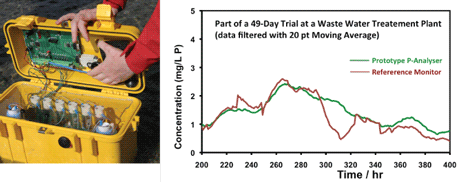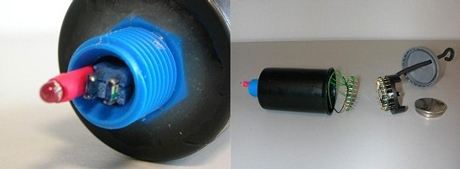by Jer Hayes, Greg O'Hare, Harry Kolar and Dermot Diamond
The ultimate goal of environmental sensor networks is to realize the concept of an 'adaptive environment' - one that senses and rapidly adapts to potential incidents in order to minimize their impact.
Environmental pollution affects human health and reduces the quality of our land and water. As a result, there is great interest in monitoring water and air quality and ensuring that all areas are compliant with legislation. Ubiquitous environmental monitoring places considerable demands upon existing sensing technology. The combined challenges of system longevity, autonomous operation, robustness, large-scale sensor networks, operationally difficult deployments and unpredictable and lossy environments collectively represents a technological barrier that has yet to be overcome. The CLARITY Centre for Sensor Web Technologies is working with IBM to confront these challenges. Ubiquitous sensing envisages many aspects of our environment being routinely sensed. This will result in data streams from a large variety of heterogeneous sources, which will often vary in their volume and accuracy. The challenge is to develop a networked sensing infrastructure that can support the effective capture, filtering, aggregation and analysis of such data. This will ultimately enable us to dynamically monitor and track the quality of our environment at multiple locations. The ability to monitor quality is a prerequisite to maintaining quality, and ensures that detected pollution incidents are dealt with as quickly as possible, dramatically minimizing their impact. In effect, the ultimate goal of environmental sensor networks is to realize the concept of an 'adaptive environment' one that senses and rapidly adapts to potential incidents to minimize their impact.
In recent years an increasing number of environmental incidents have occurred which would have benefited from an adaptive environment approach. These include the detection of lead in water supplies, cryptosporidium outbreaks and, as recently reported by the Irish EPA, and high pollution levels in a third of Irish rivers and streams. In Ireland and the rest of the world, proper management of environmental resources is critical for both health reasons and for the sustainable exploitation of these resources. Sensor Web technology such as low-power wireless communications, coupled with the emergence of new and reliable sensors such as the microfluidic analyser platform developed by CLARITY (see Figure 1), now enable environmental data to be collected at much higher temporal and spatial resolutions. Other examples of sensors being developed by CLARITY researchers are very low-power and low-cost colorimetric sensors that can be fabricated by modifying commercial optical components with chromo-responsive films. For example, inexpensive yet sensitive chemo-sensors can be made by applying such coatings to light emitting diodes (LEDs), as shown in Figure 2. Detailed experimentation with these devices in the field has demonstrated their effectiveness at detecting and tracking the dispersion of volatile chemical plumes. Continued improvement in the long-term reliability of chemical sensing platforms, coupled with significant reductions in their cost is the key to enabling scaled-up deployments of sensors at multiple locations, and this is a key goal for the CLARITY-IBM team.

Sensor networks provide a web of interconnectivity: multiple sources of information that will allow decision-making processes to be more accurate and efficient. These processes can be complex and demanding however, and are often constrained in a number of possibly conflicting dimensions such as quality, responsiveness and cost. CLARITY researchers and IBM are working together to examine in-situ decision making, whereby decisions are effected based upon inferences made from both locally sensed data and data aggregated from sensor networks. The in-situ sensor nodes that comprise a sensor network are often computationally challenged with respect to processing power, as they are developed to be low-cost, low-power devices rather than high-performance computing devices. This computational challenge places a major constraint upon the reasoning process. To overcome this challenge, CLARITY and IBM are developing a hybrid reasoning approach to deliver in situ decision-making that combines stream-based computing with multi-agent system techniques. The hybrid reasoning approach builds on System S, an IBM technology for distributed stream processing, and Agent Factory, developed by CLARITY researchers to provide a powerful collaborative decision-making system. In partnership with the Irish Marine Institute, this hybrid approach is being tested through an environmental demonstrator project entitled SmartBay, which seeks to deliver an infrastructure to validate distributed in-situ real-time environmental monitoring technolgies.
SmartBay is a next-generation water management system (both marine and freshwater), aspects of which are currently under development by CLARITY for the Marine Institute of Ireland. It is located at Galway Bay on the Atlantic seaboard of Ireland. Collaboration in the development of SmartBay will form a core activity of the Global Centre of Excellence for Water Management, established by IBM in Ireland in 2008. SmartBay-related research will mirror the monitoring activities in the Hudson River in New York State of the Beacon Institute for Rivers and Estuaries, and will in part compliment the River and Estuary Observation Network (REON) established for that purpose.

The application of Sensor Web technology to environmental sensing will eventually result in the realisation of the 'adaptive environment' concept, though networks that can rapidly detect and adapt to potential environmental incidents, in order to minimize their impact. CLARITY and IBM are demonstrating key technological building blocks of the adaptive environment through projects such as SmartBay, through which new sensing and collaborative decision-making technology is being used to test elements of a networked sensing infrastructure that can support the capture, filtering, aggregation and analysis of environmental data. While the initial real-world benefits of such technology will be in the environmental domain, these benefits will ultimately belong to any application area of the Sensor Web.
Links:
CLARITY: http://www.clarity-centre.com/
IBM Big Green Innovations: http://www-03.ibm.com/technology/greeninnovations/
SmartBay:
http://www.marine.ie/home/services/operational/SmartBay/SmartBay.htm
Please contact:
Dermot Diamond
CLARITY Centre for Sensor Web Technologies, Dublin City University, Ireland
E-mail: dermot.diamond![]() dcu.ie
dcu.ie
Harry Kolar
IBM, T.J. Watson Research Center, USA
E-mail: kolar![]() us.ibm.com
us.ibm.com










